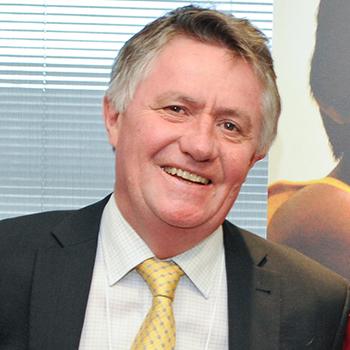“We’ve worked hard to raise the profile of child TB, because no child should die of a disease that has been preventable, treatable and curable for 70 years.”

Steve Graham knows what it is like not to be able to breathe. As a child growing up on a farm in Australia, he suffered from very severe asthma and at a time when few effective treatments were available.
“Because of my own experience, perhaps I empathize with children who have lung disease, and I certainly like to focus on providing the evidence to implement effective interventions in high mortality settings” says Graham, who became a paediatrician specialising in tropical medicine and wrote his PhD dissertation on the impact of HIV on respiratory disease in children.
Tuberculosis was not a major focus until he took a position with Malawi's newly established College of Medicine in 1995. There, upon arrival, he was asked to manage the child TB clinics, in addition to many other roles. Over the next 12 years, he treated many young patients with TB, and this experience allowed him to provide input to guidelines that were relevant to the resource-limited setting.
Graham met Tony Harries through the College of Medicine – and he became not only a squash partner, but also a mentor and friend. Harries persuaded him of the importance of going beyond the bedside to collect national data and conduct operational research.
It was also Harries who encouraged him to submit an abstract to the 1996 Union World Conference. This became a pivotal moment in Graham's career as a researcher, and he has gone on to publish more than 200 books, chapters, reports, articles and reviews. He has also been actively involved with The Union ever since, as a section officer, Board member and consultant. (That conference in Paris was important for his personal life too. He invited a friend from Liverpool to join him after the conference – and today they are married with three children.)
Through The Union and his work in Malawi, Graham also came to know Don and Penny Enarson, who "welcomed me into the fold". From 2000 to 2005, Graham worked closely with Penny on the Malawi Child Lung Health Programme, which used standardised case management to reduce the case fatality rate for severe pneumonia in children under 5 by up to half in some hospitals.
But over the past decade he has become most widely known as one of the world's leading experts on childhood TB. In addition to his work with The Union's Child Health Division, he is chair of the Stop TB Partnership's Working Group on Childhood TB, Associate Professor of International Child Health at the University of Melbourne, and an Associate Editor of the International Journal of Tuberculosis and Lung Disease.
Childhood TB has become an increasingly high-profile issue, thanks in good measure to Graham and The Union. He recalls that, when The Union first offered sessions on childhood TB at the World Conference 10 or 12 years ago, only a handful of people would come.
"It was the same people every year, and we'd take turns being the speakers", he recalls. But they persisted, and The Stop TB Partnership Working Group on Childhood TB was formed at The Union offices in 2003. "Now", he says, "the child TB sessions are standing room only."
The shift is due to in part to efforts to assess the success of the Millennium Development Goal campaign to reduce childhood mortality, since tuberculosis is increasingly recognised as relevant in the context of child survival.
"In the past, paediatricians have criticized national TB programmes for not focusing on children", says Graham. "But in limited-resource settings, the emphasis in TB control has been on dealing with the most infectious cases – and those are not children. In addition, sick children present to child health services, not TB clinics. That's why these services need to be able to diagnose and treat children with TB as well as provide preventive therapy for child contacts – and report their data to the NTPs".
This integrated approach is central to the new Roadmap to Stop Childhood TB: Towards Zero Deaths, which Graham and Union colleague Dr Anne Detjen helped to write.
The response to the Roadmap is another indicator of the public health community's greater awareness of childhood TB. It was sponsored not only by WHO, the Stop TB Partnership, The Union, Treatment Action Group, USAID and the CDC – but also UNICEF. The launch on 1 October in Washington, D.C. was very well attended, and The Washington Post, BBC, USA Today and other widely read media carried the news. The following day, several representatives were invited to meet with US Congressmen to talk about the plight of children with TB and for the need for continued investment in global TB control.
For Graham and The Union, this intensified interest is very hopeful sign. "We've worked hard on raising the profile of child TB, because, regardless of the challenges, no child should have to die of a disease that has been preventable, treatable and curable for 70 years".
